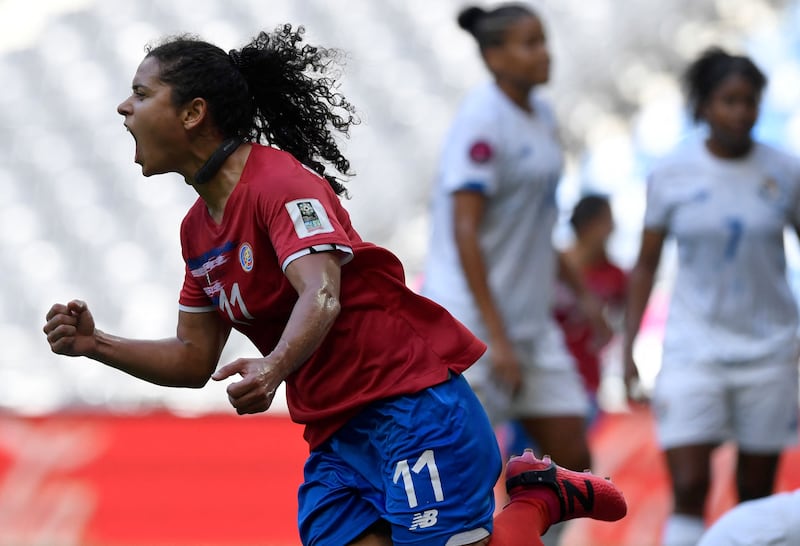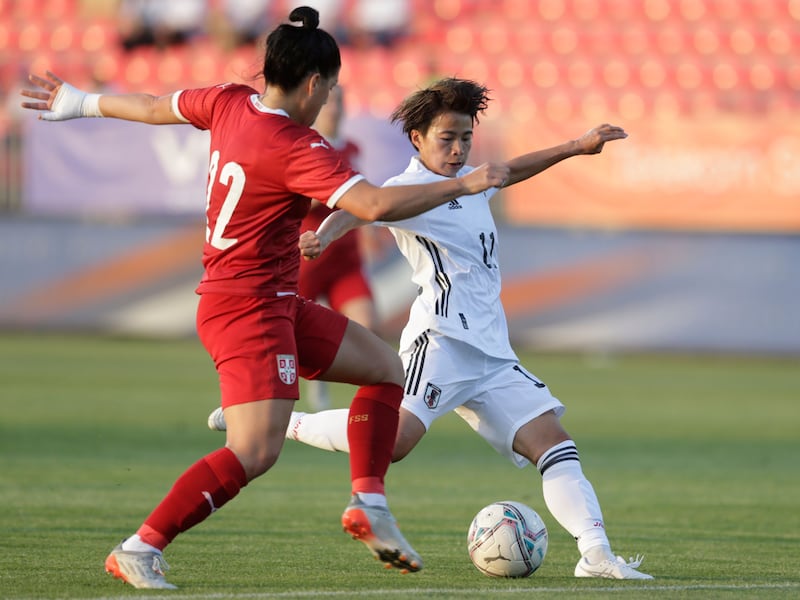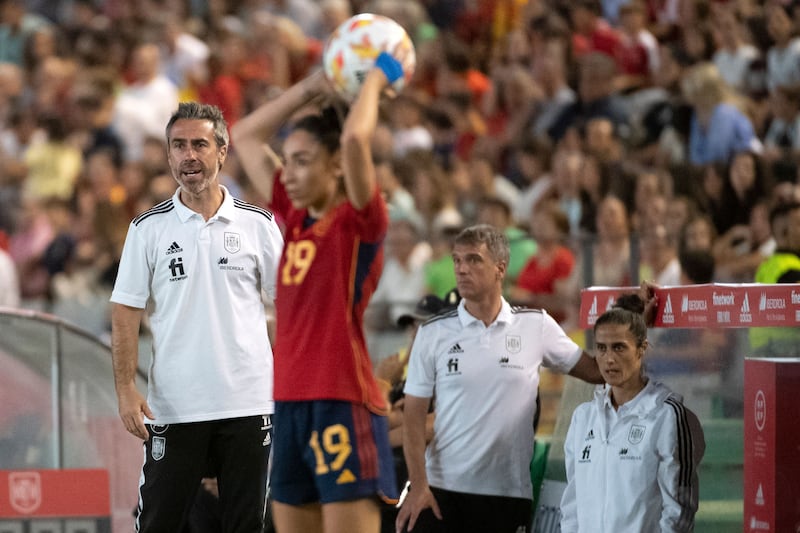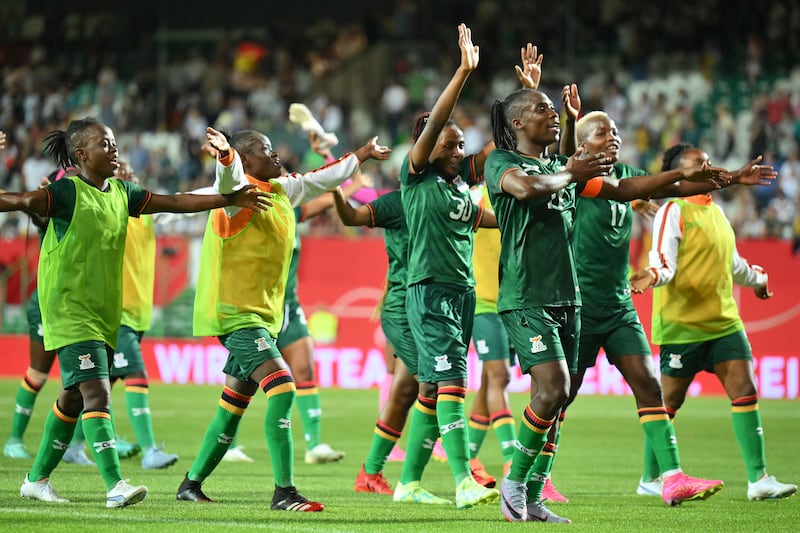Costa Rica

Overview
The Costa Rican national team is generating excitement and passion at home as they participate in a Women’s World Cup for only the second time, and with a generation of players considered the country’s best so far. They had a perfect preliminary round in the qualifiers, winning all four games, scoring 22 goals, and keeping four clean sheets.
In the subsequent 2022 Concacaf Championship in Mexico, Costa Rica defeated Panama 3-0 and then Trinidad and Tobago 4-0. Those victories earned Las Ticos a semi-final spot and while that match ended in defeat to eventual tournament winners the USA, their last-four finish was enough to secure qualification for the World Cup.
The team is led by coach Amelia Valverde, who has been in charge since 2015 and has a solid mix of experienced performers and young talents. Key players to watch include Raquel Rodríguez, Melissa Herrera and Priscila Chinchilla, who have consistently made a difference for the national team. However controversy arose when the former captain, Shirley Cruz, was left out of the pre-World Cup squad despite her successful career and contributions to the national team. The 37-year-old Cruz subsequently retired in June.
Copa 71: ‘These women were gaslit. Imagine playing a sport at the highest level and then being told, that didn’t exist’
Amber Barrett: ‘I say nothing when I don’t know the full truth ... The social media people should have done the same’
Sports Review 2023: Magical moment as Katie McCabe creates history
Katie McCabe interview: ‘It’s important to have characters, you don’t want a team of robots’
Valverde puts World Cup qualification down to the discipline, respect, loyalty and hard work of her players. “This national team always teaches me something new, it pushes me to improve,” she told fifa.com. “When facing adversity, the players have always remained close-knit. For us – no matter the external circumstances, the results, people’s comments or anything else – we value the players’ efforts and who they are as individuals above their role as footballers.”
Costa Rica will face Spain, Japan and Zambia in Group C, aiming to improve on their performance in 2015 and make history by reaching the knockout stage for the first time in the senior women’s team’s history.
The coach
Amelia Valverde, a 36-year-old Costa Rican, is a physical education teacher by profession and a former player in the Primera División Femenina. She first joined Costa Rica’s coaching staff during qualification for the 2015 World Cup in Canada, unexpectedly taking charge months before the tournament began at the age of only 28. After the World Cup, Valverde continued as the head coach, facing both triumphs and setbacks, including missing out on qualification for the 2019 World Cup in France and subsequently securing qualification for the 2023 event in Australia and New Zealand.
Star player
Costa Rica’s all-time leading scorer, Raquel Rodríguez is a midfielder who has reached 100 appearances and scored 55 goals for the national team. The 29-year-old is a tenacious player on the field and a leader. She was the first Costa Rican woman to score in a World Cup.
“In Costa Rica, we don’t have an army, so we always say that the soccer field is like our battlefield, for lack of a better term,” she told fifa.com. “Fans want to feel proud of what they’re watching, and that’s something we want to give them.”
Rising star
Alexandra Pinell, a 20-year-old midfielder, first caught the attention while playing in the second division in Costa Rica. She is now expected to become one of the best players at her current club, Liga Deportiva Alajuelense, and is the captain of Costa Rica’s Under-20 team. Pinell scored a memorable 40-yard free-kick against Australia in the 2022 Under-20 Women’s World Cup. While shy off the field, she excels on it, displaying speed, game-reading skills and a powerful shot.
Did you know?
Sofía Varela, a forward for Costa Rica, has experienced two anterior cruciate ligament injuries, one in each leg. But she has never lost her joy for the game. Varela has tattoos of the Arenal Volcano, located in her hometown of La Fortuna de San Carlos, and the map of Costa Rica. When she scores abroad, she proudly displays them in honour of her beloved country.
Standing of women’s football in Costa Rica
Although not professional, women’s football in Costa Rica has been growing, with record attendances and two television channels covering matches in the Costa Rican top flight. There are 448 registered players, making it the most popular sport among young Costa Rican women, who can now find a women’s soccer team in their neighbourhood.
Realistic aim at the World Cup?
The national team faces tough and diverse opponents in Group C. Their only previous World Cup ended with two draws and one defeat, so Costa Rica will aim to surpass their past achievements, thanks to a solid coaching foundation. Reaching the knockout stage is a concrete objective. “We have very high expectations,” said Rodríguez. “We want to go there and compete. Costa Rica has never advanced past the group stage, so it’s a very specific goal for us.”
Written by Fiorella Montoya for La Nacion.
Japan

Overview
The Nadeshiko Japan women’s national team had a magnificent start to the last decade, being crowned as champions at the 2011 World Cup in Germany and winning a silver medal at the London Olympics the following year, before a runners-up finish at the 2015 World Cup in Canada. However, the reality is that the current generation has not yet lived up to the heightened expectations, with elimination at the round of 16 in 2019 and the quarterfinals at the Olympics two years ago.
The Portland Thorns midfielder Hina Sugita, however, recently spoke of the sense of urgency among her team-mates. “We were very disappointed not to progress further in the past. If we don’t dig in our nails now, it’s only going to get tougher for women’s football in this country,” she said. The current coach, Futoshi Ikeda, took over in October 2021 with the task of giving the team a new start towards reclaiming that title of world champions. This World Cup will be their first global competition since he took over.
This year’s team features many players who have performed well at underage category World Cups in the past, and as a collective is clearly improving with each passing match. Defender Moeka Minami says “we want to use this World Cup as an opportunity to reinvigorate women’s football in Japan”.
One of the team’s key players, Yui Hasegawa, has a sparkle in her eyes when talking about the World Cup. “Results now are everything when we think of the future for women’s football in Japan. I’m looking forward to showing how much of a difference I can make individually. Succeeding at the World Cup is now our immediate objective. I want us to express our qualities as Japanese on the pitch.”
Undoubtedly, the team’s performances at this World Cup will have a major impact on public enthusiasm for women’s football in Japan going forward. Ikeda certainly piqued interest in the tournament by leaving out star player Mana Iwabuchi from their World Cup squad. “Iwabuchi is a player who has done a lot to drive this team forward but I am choosing 23 players for this specific time and there is no one reason for my choices,” Ikeda said. “It’s about form, fitness, the state of the team and what we need in certain situations.”
The coach
Futoshi Ikeda. The coach who led Japan to glory at the Under-20 Women’s World Cup in 2018, Ikeda has chosen several of his former players for the full national team this year as well. His professional playing career as a defender lasted four years, all spent with Urawa Reds, while as a manager he is known for his cheery personality and passionate leadership. The players have bestowed upon him the nickname “Atsuo”, meaning “fiery man”, and they are strongly supportive of their manager. The striker Mina Tanaka says “he always finds the right words to send us on to the pitch full of bravery and confidence”.
Star player
Mina Tanaka. At 29 years of age, she is the oldest forward in the squad, and her 28 goals make her the highest scorer too. She has developed into an experienced striker and has finished as top scorer of the Japanese domestic league four times. Her ability to perform when it counts has been evident ever since her full international debut in 2013, when she scored against Germany. Tanaka is capable of unleashing powerful shots with either foot, can break behind defensive lines, and is physically strong enough to hold up play as well.
Rising star
Aoba Fujino. An exciting new face recently named as one of five rising stars in Japan’s WE League. But Fujino is self-critical: “I’m happy to get such a great honour, but I’m not there yet. I want to develop into the sort of player worthy of such acclaim.” She was only called into the full national squad for the first time last year, but she is already a massive presence in the side and clearly prepared for this World Cup. “Being young is no excuse when you’re out on the pitch. I want to compete and show my best on the world stage.”
Did you know?
Riko Ueki absolutely loves manga. She has a social media account dedicated solely to it, where she even streams live video on a manga theme. Her walls at home are covered in manga pictures, and she has a collection of over 1,000 volumes on her shelves. She always reads manga on her way to matches.
Standing of women’s football in Japan?
The environment for women’s football in Japan has changed significantly since the national team won the World Cup in 2011. More girls have taken up football and it is now one of the most popular sports for girls and women in Japan. The first fully professional league, the WE League, was launched in 2021-22 and has now completed its second season. All matches are shown live on the streaming service DAZN, but with viewing figures still relatively limited, performances at this World Cup will be key to its future popularity.
Realistic aim at the World Cup?
Japan are of course aiming to become world champions, but the first goal is to reach the quarterfinals after failure to do so in 2019. The team is still developing, and it should be able to grow into title contenders throughout the tournament.
Written by Mari Hibino. Translated by Ben Mabley.
Spain

Overview
Spain enter their third World Cup established as a global force. La Roja have become a fixture in the top 10 of the world rankings – they are currently sixth – and travel to Australia and New Zealand optimistic of a deep run in the tournament, despite recent major upheaval in their set-up.
Late last year, 15 of Spain’s regulars walked away from the national side in protest against head coach Jorge Vilda and his back room team. This forced Vilda to turn to players further down the pecking order. Since then, a reshaped and eager group is pulling in the same direction. Recent results have been impressive. There have been wins against teams such as the USA and Norway, a 7-0 thrashing of Argentina and a draw with Sweden.
After a turbulent few months, Spain head down under having successfully relaid the foundations of their side. They also welcome back three of their rebels: Mariona Caldentey, Ona Batlle and Aitana Bonmatí. The Barcelona trio had been key players for Spain before the mutiny and their return represents a boost to the team’s chances of success at the World Cup.
“If these three players are here it is because they are committed to the national team and by extension they can play in the World Cup,” said Vilda, who has avoided discussing specifics about the 2022 walkout. “I’m convinced that we will form a united group.”
Drawn with Costa Rica, Japan and Zambia in a group that is, on paper, fairly straightforward, Spain are clear favourites to finish top of Group C. And in a further shot in the arm for the team’s ambitions, Irene Paredes, Jenni Hermoso and Alexia Putellas are also back in the fold. Although she only recently returned from a long injury absence, Ballon d’Or holder Putellas has her sights set on being Spain’s driving force at the World Cup. With Paredes and Hermoso, she brings experience to a young squad; many of Vilda’s charges are going to a major international tournament for the first time.
The coach
Jorge Vilda wants to make history with Spain. The 42-year-old took over in 2015, when Ignacio Quereda was sacked after the Canada World Cup, having failed to get out of the group in the country’s first appearance at the tournament. Vilda had been a stalwart of the coaching set-ups in Spain’s age-group teams, and in his tenure as senior manager he has promoted players such as Bonmatí, Patri Guijarro and Athenea del Castillo. As he prepares for his second World Cup at the helm, Vilda knows his team is one of the best on the planet.
Star player
Alexia Putellas, 29, is Spain’s undoubted star. This tournament is a golden opportunity for the midfielder to shine with the whole world watching. Last summer, Putellas was robbed of the chance to dazzle on the big stage when an anterior cruciate ligament tear ruled her out of the Euros. Having recently returned from 10 months on the sidelines, the back-to-back Ballon d’Or winner is set to pull the strings for Spain once more.
There is a slight doubt, however, over whether she’ll be fit to start from the get-go. A 7-0 win against Panama in a friendly in June was her first start this year, with Putellas scoring after 22 minutes. “The sensations were very good, not just for the goal that she scored but for her assists, for how she helped the team,” said Vilda. “That’s what we expect from Alexia, but it’s clear the best of Alexia is still to come, and we’ll do everything on our side to make that happen.”
Rising star
Vilda has placed great faith in Salma Paralluelo. A year ago, she was a surprise pick for the Euros (albeit injury ultimately ruled her out of the tournament); since then, she has been a regular fixture for Spain. At 19, the forward has a very bright future ahead of her for country and club, having slotted in seamlessly at Barcelona since joining last summer.
Paralluelo, who scored a hat-trick on her Spain debut against Argentina, is blessed with immense physical prowess and doesn’t seem to be fazed by anything. Asked whether she could imagine winning the World Cup this summer, Paralluelo told fifa.com: “Of course. You always have to visualise these things. [But] the first thing we have to do is focus on the group stage. We can’t look beyond that.”
Did you know?
This is the ninth Women’s World Cup and only the third for which Spain have qualified. It wasn’t until 2015 that La Roja first appeared at the tournament – and they endured an unhappy debut, falling at the first hurdle. In the years since, Spain have made relentless progress, qualifying for every major tournament. They now need to take the next step on the biggest stage.
Standing of women’s football in Spain
Women’s football has well and truly arrived in Spain. The national team is on the up, and Liga F, the country’s elite domestic league, is now fully professional. Spain took its time to embrace the women’s game, but once it did, success followed. Just look at Barcelona, who have won the Champions League twice in the last three years. Spain is brimming with talent; judging by last year’s Under-17 and Under-20 World Cup victories, the future is bright.
Realistic aim at the World Cup?
Under pressure to go further than at previous major tournaments, Spain head to the World Cup with big ambitions. At a bare minimum, they ought to make it through their group and through the last 16. The quarterfinals, where the USA could await, would then be pivotal to how Spain’s campaign is viewed. Make it to the semi-finals, and the tournament would be seen as a success. Anything beyond that would be a truly momentous achievement.
Written by Amalia Fra for AS in Spain.
Zambia

Overview
The Zambia women’s side is one of Africa’s fastest-rising teams, having been the only African women’s football representative at the 2020 Tokyo Olympics. The Copper Queens also reached the 2022 Women’s Africa Cup of Nations (Wafcon) semi-finals in Morocco, which secured their qualification for a Women’s World Cup debut in 2023.
Women’s football is still developing in Zambia. However the national team has achieved significant success despite the challenges, including third place at the 2022 Africa Cup. The majority of the players have been employed full-time by the air force and army to play football for the two most prominent women’s military clubs in Zambia: Red Arrows and Green Buffaloes.
Despite having a young squad, with some of the local players earning less than $50 a month at their respective clubs, Zambia defeated top-ranked teams such as Senegal, Tunisia and Nigeria at the Wafcon in Morocco. Their only defeat was by eventual tournament winners South Africa in the semi-finals.
During the tournament, Zambia were missing their top strikers, Barbra Banda and Racheal Kundananji, who were disqualified from competing due to high testosterone levels, according to the Zambian FA. Following Wafcon, Zambia won the 2022 Cosafa Women’s Championship for the first time with Banda finishing as the top scorer with 10 goals and named player of the tournament.
However Zambia have struggled this year, including a 10-2 aggregate loss to South Korea across back-to-back friendlies in April. Banda and Kundananji are still trying to adjust to playing as a pair since their return to the squad, with the coach, Bruce Mwape, admitting to BolaNews that “there is a lot of individual play up front; everyone wants to show that they are stars. We are currently working on it.”
Kundananji finished the 2022-23 season as the second-highest goalscorer in the Spanish league, with 25 goals for Madrid CFF. Banda scored nine goals in six games for Shanghai Shengli in the Chinese Super League. But in the pre-tournament friendly against Germany it all seemed to come together, with Banda scoring a 3-2 winner in the 12th minute of added time.
The coach
Bruce Mwape took over as head coach in 2018 after leaving Zambian Super League club Nchanga Rangers, but his tenure has been rocked by allegations of sexual misconduct. According to the FAZ president, Andrew Kamanga, the investigation was referred to the police and Fifa to ensure that it is not accused of “taking sides”. There has not been a verdict yet. A holder of the Caf A licence, the highest level of coaching licence attainable on the continent, Mwape has led the Zambia women’s team to the Africa Cup of Nations twice, the first time being in the same year he was appointed. Mwape has a reputation for playing physical, attacking football. He has previously been chastised for the team’s poor defending, but he has stated: “We are working on improving our defence, and we will be fine at the World Cup.”
Star player
During Tokyo 2020, Barbra Banda made history by becoming the first woman in Olympic history to score consecutive hat-tricks. Despite the underwhelming Copper Queens’ performance, the Shanghai Shengli forward stood out as one of the most exciting players at the tournament. On her aims going into her debut World Cup, Banda told FAZ media: “We need to go there with full force and the mentality of winning.”
Rising star
Evarine Susan Katongo is widely regarded as Zambia’s next big star. The 20-year-old midfielder began her career at the Luyando Foundation in Lusaka’s shanty township of Chinika. She quickly rose through the ranks of the Zambia national team, becoming a key figure in the squad at the age of 18.
Katongo is best known for her holdup play and dribbling abilities. However, she has had some issues at club level, having not played for six months after the Wafcon due to contractual disputes between Luyando and the Zambia Institute for Sustainable Development (ZISD FC), which were later resolved. This hasn’t slowed her progress, and Katongo stood out in a friendly match against Tanzania at a packed 10,000-seat Woodlands Stadium in Lusaka, thrilling the crowd.
Did you know?
Banda, the Copper Queens captain, was a professional boxer with Oriental Quarries Boxing Promotion from 2015 to 2017. She competed in the bantamweight division five times, winning all of her fights, four by knockout.
Standing of women’s football in Zambia
Women’s football has improved significantly since the late 2000s, becoming more popular among Zambians, with the national age-group teams now regularly competing in international tournaments. The FAZ launched the Women’s Super Division in 2021, resulting in an increase in the number of women’s clubs. Despite the fact that the league is solely sponsored by FAZ and is not broadcast on television, it has produced several players who are now playing professional football outside of Zambia.
This pathway has changed the lives of some international players, with the top earners in the squad taking home over $5,000 per month. During the Women’s World Cup trophy tour, the FAZ president, Andrew Kamanga, said: “I wish to appeal to our partners in the corporate world to support women’s football.”
Realistic aim at the World Cup?
The majority of the Copper Queens have never played professional-level football before, and the technical staff are also adapting to international standards. The team’s primary goal should be to gain experience, and progressing from Group C (containing Japan, Spain and Costa Rica) will be a huge bonus. Banda told the FAZ media that the World Cup is a “huge task, but the mentality of being a player is that we need to be positive every time.”
Written by Calvin Kaumba Chikenge for BolaNews.




